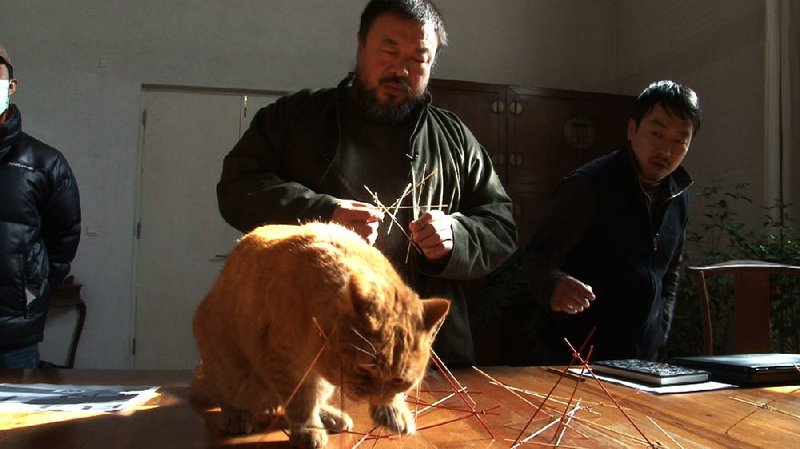LITTLE ROCK — Ai Weiwei: Never Sorry
87 Cast: Documentary, with Ai Weiwei Director: Alison Klayman Rating: R, for language and a recurrent obscene gesture Running time: 91 minutes
In English and Mandarin, with English subtitles
Early on in Ai Weiwei: Never Sorry, Alison Klayman’s straightforward, entertaining and provocative documentary about the titular Chinese artist, we catch a glimpse of the cat who can open doors. In a remarkable scene, caught by the fortunate documentarian’s cameras, a large, long-haired feline leaps twice her body height in the air to flick a door handle that allows her to exit the artist’s home/studio and make her way into the serene courtyard.
“Out of the 40 cats, one knows how to open doors,” Ai says in admiration. “Where did this intelligence come from? All the other cats watch us open the door. So I was thinking, if I never met this cat that can open doors, I wouldn’t know cats could open doors.”
Most can’t. It takes a remarkable cat to open doors. Ai is another remarkable cat. He is, as another Chinese artist says, “not the kind of person we are familiar with in China. He doesn’t work within the system. He’s just himself.”
Klayman began filming — or videotaping — him in 2008, as a favor for a friend. Her timing couldn’t have been better. Not only had Ai become world famous as a conceptual artist who had helped design the distinctive Bird’s Nest stadium for the 2008 Beijing Olympics, he’d defied the government by calling for a boycott of the Games in protest of China’s human-rights abuses.
And then came the Sichuan earthquake, in which thousands of children died when their poorly built (“tofu constructed”) schools collapsed. When the Chinese government refused to release specifics about the victims, Ai launched a project to collect and publicize the names of more than 5,000 victims, a project that enlisted hundreds of Chinese volunteers.
In 2009, at his retrospective show “So Sorry” in Munich, Germany, Ai created one of his most famous pieces, Remembering, an installation of 9,000 backpacks that spelled out, in Mandarin characters, a quotation from a mother of one of the earthquake victims: “She lived happily for seven years in this world.”
Ai emerges as a heroic, merry prankster, whose pushback against Chinese authority has taken its toll. He almost died after being struck by a police officer who was officially cleared of wrongdoing (we actually hear the assault in the film, because Ai recorded it), and last year he was arrested and held incommunicado by the government for 81 days, during which he was convicted of tax evasion and fined $2.4 million in unpaid taxes and penalties.
Yet he has so far escaped the fate of other Chinese dissidents, probably because of his international fame (Art-Journal has declared him the most powerful artist on the planet) and following. (Or maybe it’s his impish persona, which suggests a cuddly bear of a man, with an easy smile, a formidable intelligence and more than a hint of narcissism. The only time he appears the least bit uncomfortable is when he’s questioned about an extramarital affair.)
Klayman stitches together a remarkable portrait of an atypical Chinese life. Ai is the son of a famous poet disgraced and exiled to the provinces during the Cultural Revolution who became a scene-making hipster in Manhattan, where he lived for 12 years.
I wish Klayman had spent more time on Ai’s work, for the film seems to suggest he’s mostly chutzpah and charisma, the sort of artist who employs crews to assemble his work. We’re given to understand that Ai’s life and art have by now become inseparable — he documents his own edgewalking existence. Ai is a provocateur and activist; his continued existence is an implicit critique of his government.
Which is why so many people fear for him. And why, he admits, he is so fearful. (“The danger is really there,” he says, “but the danger is stronger if you don’t act.”)
The film is a beautiful, fluid example of digital storytelling, seamlessly integrating smart-phone footage with striking images, such as a beautiful sequence in London’s Tate Modern gallery, where Ai and his young son walk over a field of 100 million hand-painted ceramic sunflower seeds Ai commissioned for his show.
The metaphor set up in the movie’s early moments is clear — Ai is the kind of cat who opens doors. And unlike most people, he doesn’t pull them closed behind him.
MovieStyle, Pages 35 on 08/31/2012
